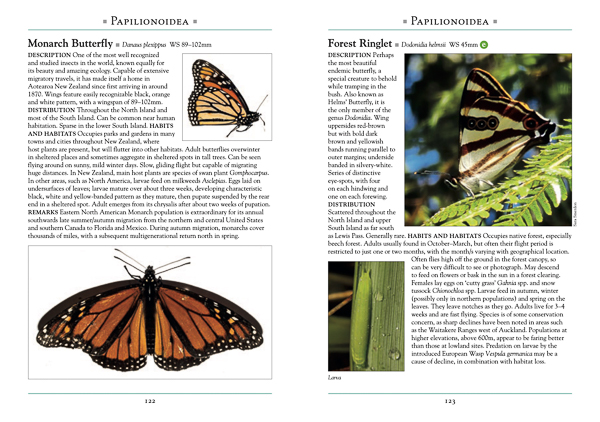 |
by Carey Knox.
A Naturalist's Guide to the Butterflies & Moths of Aotearoa New Zealand is an easy-to-use introductory identification guide to 361 species of butterfly and moth found in Aotearoa / New Zealand. High-quality photographs from the author and the region's top nature photographers are accompanied by detailed species descriptions, which include nomenclature, size, distribution, habits and habitats, and conservation information. The user-friendly introduction covers geography, habitats, moth and butterfly identification, survey methods and a glossary. The final section contains an all-important checklist of all of the Lepidoptera of New Zealand.
The publication of this extremely useful and affordably priced identification guide is a welcome addition for anyone with an interest in the butterflies and moths of Aotearoa New Zealand. Although only providing an introduction, covering 360 (c.20%) of the c.1750 named Lepidoptera species, this is certainly the best book of its kind currently available. There are no comprehensive guides in print, and the only comparable introductory guide covers a little over 150 species.
A short introductory section provides background to New Zealand’s Lepidoptera, geography, climate and habitats, followed by an account of butterfly and moth anatomy, life cycle, identification and conservation, then an explanation of the layout of the book and how to use it. Its pocket guide format makes it ideal for fieldwork.
 |
The main body of the book comprises the individual species accounts, with a half page or full page (plus photograph) for each, and multiple species images for those genera (e.g. Pugs, Eudonia spp., Scoparia spp.) comprised of many similar species. For a small book, it's packed with information and presented in a style that makes it informative and accessible to beginners and experts alike. The photographs (mostly the authors own) are of excellent quality, with most species shown against a white background, thus removing any distracting background texture. All images are of wild photographed individuals, displaying their typical resting position. The only criticism I would have of the layout is that it is arranged in alphabetical rather than taxonomic order of families. This non-taxonomic arrangement makes it harder to use as an identification guide, since closely related micro-moth families are dispersed through the book rather than following sequentially.
 |
In summary, the author has done a great job in making this a very readable, beautifully illustrated and informative guide. There’s so much useful and up to date information in the species accounts, including helpful guidance on species variability and ecology. Whether you're just embarking on your journey into the weird and wonderful world of Aotearoa New Zealand's Lepidoptera, or someone who already has an interest, it certainly deserves a place on your bookshelf. I would strongly recommend it to anyone who is planning a visit or already lives in Aotearoa New Zealand.